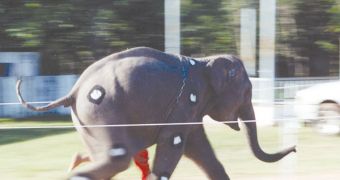You can say that a four-limbed animal is running when at a given moment all its four limbs are in the air or its gravity center moves up and down in a pogo stick-like motion.
It is said that the elephant does not run because they simply cannot do it. But when an elephant speeds up, can that be called just fast walking? In the end, African elephants can reach 40 km (25 mi) per hour, overrunning any human athlete and even cars in the bush!
To solve the puzzle, in 2003 John Hutchinson of Stanford University in California with an American-Thai team made complex biomechanical video analysis of Asian elephants.
"For their size, elephants have fairly small muscles, which would make them analogous to an obese humans or people with weak or paralyzed muscles. Understanding how elephants move so quickly could lead to new strategies to help some patients exercise or move about," said Stanford.
The team videotaped 42 healthy animals, from 600 kg youngsters to 3 tonnes adults, whose joints had been colored with white dots, easy to follow on recordings. The cameras recorded 240 pictures/second.
The elephants' maximum sustained "running" rhythm of 25 km (16 mi) per hour is speedy enough, in theory, to launch the beasts into an aerial gate, still the animals always had three feet on the ground, and the high speed was just an accelerated four-step gait of the slow walk.
But the video analysis of the hip joints showed that the elephants were really running, in a biomechanical sense. The hind limb balanced downwards in the middle of the stride and then upwards, a typical trait of running. But the shoulder's spot analysis exposed first an upward movement and then downwards, the classical biomechanical model of walking.
"Avoiding an aerial phase could be important for a large animal. They wouldn't have to endure the shock of leaving the ground and falling back down." said Hutchinson.
Moreover, youngsters did not trot or gallop; their gait was a miniature of the elders.
"It would certainly be an advantage to them escaping predators," said Hutchinson, as lions and tigers can kill elephants' offspring.
But the elephant's curious running style seems to be hardwired from an early age. The question is: could the big sauropod dinosaur, the long necked long tailed small-headed herbivorous one, with elephant-like feet run? These were the largest ground beasts ever and elephants suggest one thing: no way!

 14 DAY TRIAL //
14 DAY TRIAL //